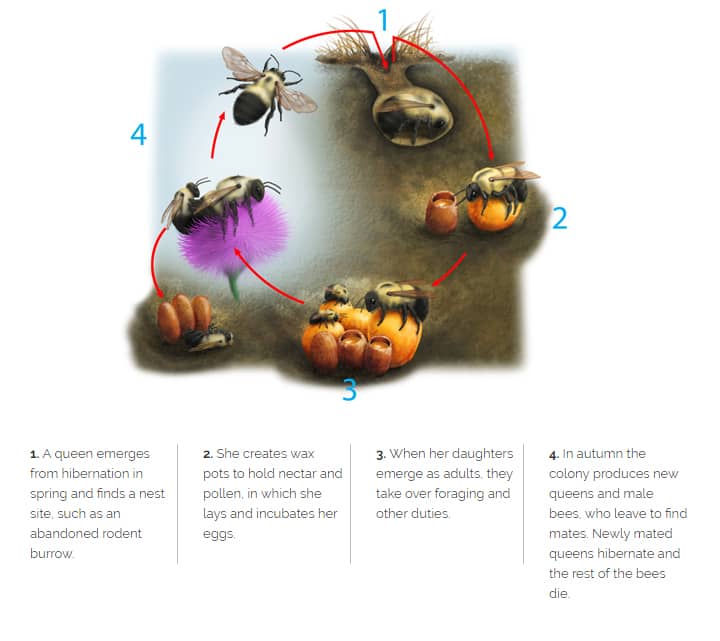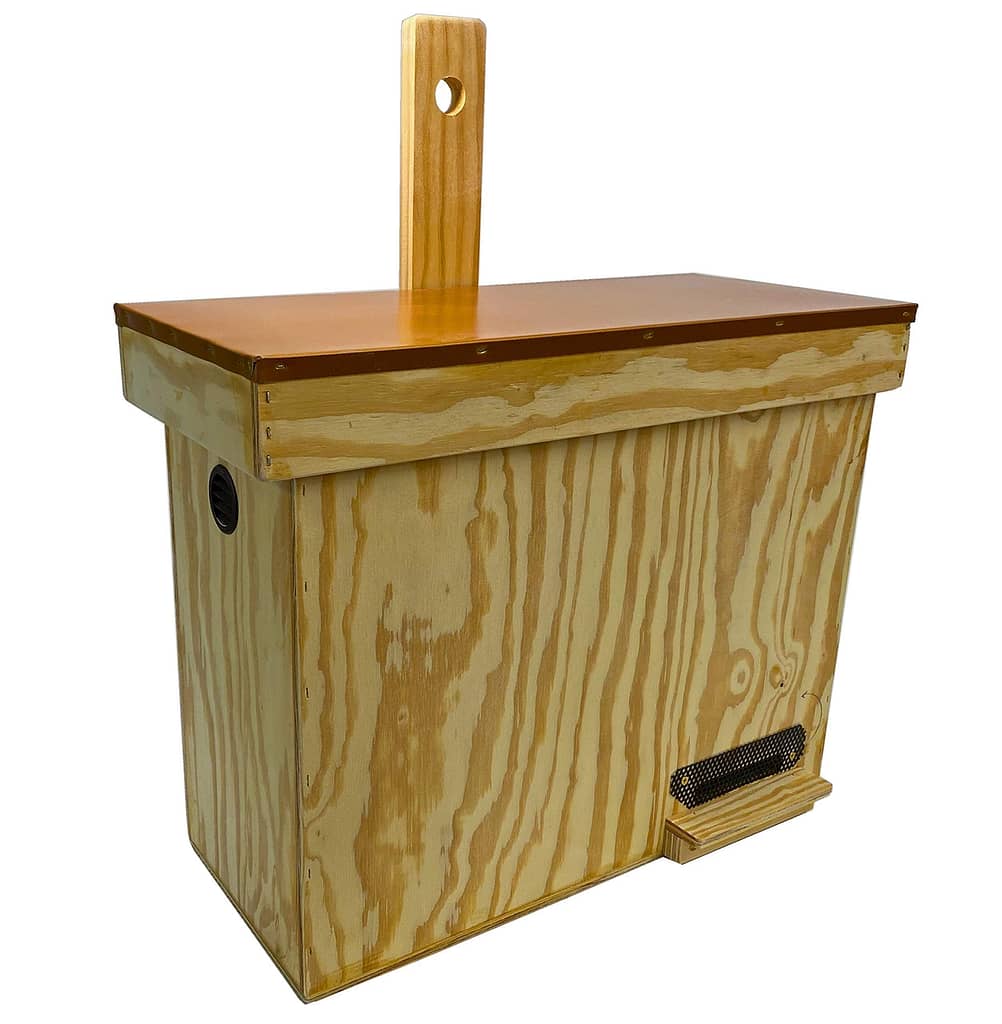
Bee prepared!
The show is about to beegin.
You maybe thinking to of asking me,
“Shirley there can’t be that many differences between honeybees and bumblebees.”
First off, don’t call me Shirley.
Second, if that were true this article would be significantly shorter. I hope you enjoy this riveting comparison as much as I enjoyed researching.
Physical Characteristics

Size and color
Honeybees and bumblebees have distinct differences in size and color. Honeybees are generally smaller, measuring between 10 and 15 mm in length, and are often a golden brown or black color. Bumblebees, on the other hand, are typically larger, measuring between 15 and 25 mm in length, and are usually black with yellow or orange stripes.
Hairiness
While honeybees have hair covering their entire bodies including their eyes they have the equivalent of a buzz cut compared to the bumblebee. I hate to have to go there but, Bumblebees are much MUCH hairier. I’m not trying to call out bumblebees or body shame. I just say it as I see it. The bumblebees extra hair allows them to collect more pollen and keep their bodies warm in cooler temperatures.
Airworthiness
Bumblebees tend to fly more slowly and clumsily than honeybees, and are more likely to land on flowers and crawl inside to collect nectar and pollen. The bumblebee is able to carry a larger payload due to its extra hair for collecting pollen and larger body in general. Honeybees, in contrast, tend to fly in a in a slightly more direct path between flowers and their hive. Bumblebees have the ability to fly in temperatures as low as 50°F provided they are able to warm themselves up by beating their wings. Honeybees minimum temperature for takeoff is closer to 54-55°F. While this doesn’t seem terribly significant on paper it can be the difference of several hours each day or even possibly several days each month of flight time available to the Bumblebee in the fall and spring each year while the honeybee is home clustered up with the rest of the colony to keep warm.
Habitat

Origins
The honeybee is believed to have originated in Africa, particularly in the regions of the Sahara desert and the tropical rainforests. This is supported by the fossil record. It is thought that humans began domesticating honeybees around 4,500 years ago in ancient Egypt, where they were kept in hives made from reeds and clay. From there, the practice of beekeeping spread to other parts of the world, and honeybees are now widely distributed across Europe, Asia, and the Americas.
Bumblebees are believed to have originated in Eurasia. Where is that you ask well don’t be embarrassed it’s the region including Russia, Ukraine, and Kazakhstan. Bumblebees are well-adapted to cold climates due again to their fuzziness, and capable of surviving in regions as far north as the Arctic Circle. Today, bumblebees can be found in many parts of the world, including Europe, Asia, and North America.
Climate
Bumblebees and honeybees also have differences in preferred climate. Bumblebees are commonly found in colder climates, such as Canada, and are usually seen in fields, forests, and gardens. They also prefer to nest in abandoned burrows, logs, or underground tunnels. There fuzzy exterior gives them the edge on body temperature regulation.
Honey bees, on the other hand, are more adaptable to warmer climates. Since Honeybees are often used for commercial purposes, such as honey production and pollination of crops they are managed and cared for in climates they wouldn’t normally survive. This includes northern United States with insulated hives and even in Canada where the hives are brought inside warm agricultural buildings during the coldest months.
Behavior

Nesting habits
Honeybees and bumblebees have different nesting habits. Honeybees live in large colonies with a complex social structure, with a single queen bee laying eggs and many worker bees supporting the colony by collecting nectar and pollen, caring for the young, and defending the hive. Bumblebees, on the other hand, live in smaller colonies, with a single queen and a few dozen worker bees. Bumblebees build their nests underground, in abandoned rodent burrows or other cavities, while honeybees build their nests in hives made of beeswax.
Colony lifecycle
Each Winter a honeybee colony largely made up of fat bodied winter bees and a single queen. During the winter there are no male bees called drones at all. They survived by eating their stores of honey. In the spring the Queen lays thousands of eggs per day to build up a foraging force that goes out and retrieves pollen their source of protein and nectar a source of carbohydrate. The Queen never leaves the hive. She stays and continues to lay eggs. If the colony grows too large for its cavity whether it’s a hollowed out tree or beat Honeybee hive Over half of the colony will leave with the Queen. This is called swarming. The remaining bees Will select a larvae order to and feed them a special diet of royal jelly to make her into a virgin queen. When she hatches she will fly away to meet. In return to the hive to begin laying. If she made successfully should only leave the hive once in her life until she swarms. If she isn’t successful she may make multiple mating flights.
In stark contrast the bumblebee queen lives a quite solitary life for much of the year. She overwinter’s all by her lonesome underground keeping warm with her extra fuzzy coat. In the spring she starts making a new hive structure for food stores and larvae to growing. Then she will go out multiple times by herself to collect the initial nectar and pollen to sustain her new daughters while they are larvae. After she has built up a good field force, the Bumblebee queen’s daughters will take up the role of foraging for resources. In the fall the colony will produce new Bumblebee queens and they will leave the colony mate and overwinter by themselves before starting their own colony in the spring.
Foraging behavior
Honeybees and bumblebees also have different foraging behavior. Honeybees tend to forage on a wide variety of flowers, including agricultural crops like almonds and apples, and are known for their ability to communicate with each other using a dance to share information about the location of food sources. Bumblebees, on the other hand, tend to forage on a smaller range of flowers and are particularly effective at pollinating plants with deep, tube-shaped flowers, like tomatoes and blueberries. Bumblebees use a technique called buzz pollination, in which they vibrate their wings to release pollen from the flowers.
Temperament
Bumblebees are generally more docile and less aggressive than honey bees. Their smaller colonies don’t allow for large swarming campaigns against aggressors like a hungry bear. Honey bees are more aggressive than bumblebees and are more likely to sting if they feel threatened. Many honeybees will be assigned the role of guarding the entrance to the hive and several thousand are prepared to leave the hive at a moments notice to respond to aggression in a mass simultaneous strike.
Efficiency
Despite the bumblebees slow and bumbling flightpath they are actually able to visit twice as many flowers in an equal amount of time compared to the honeybee. This may be due the fact that the bumblebee is native to North America and its more akin to its flora or the extra material they are able to care Before having to offload their haul at the hive.
Conclusion
Honeybees and bumblebees are similar, but not the same and both play a crucial role in our ecosystems as pollinators of many important plant species. Unfortunately, both honeybees and bumblebees are facing numerous threats, including exposure to pesticides, habitat loss, and disease. However, by taking steps to protect bees as individual we can help ensure the survival of these important pollinators. By providing a diverse range of flowers, and water sources, we can attract honeybees and bumblebees to our gardens and provide a safe and healthy environment for them to thrive. Finally, one of the most important ways we can help honeybees especially is by rescuing stranded Honey bee colonies that have swarmed and are looking for new home. Not only does this provide the new colony with the shelter and resources it needs to thrive, but also protects the our neigbhors and community.
To learn more about honeybee swarms click here.
To report a honeybee swarm See the form below.

